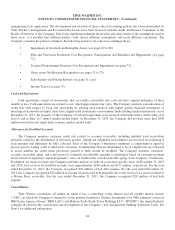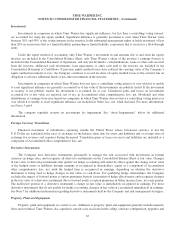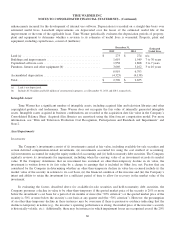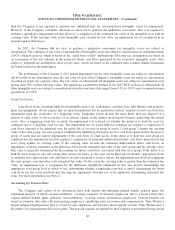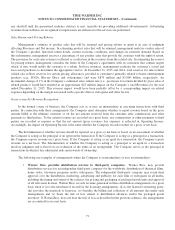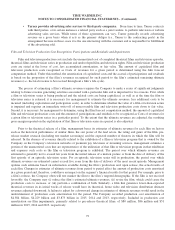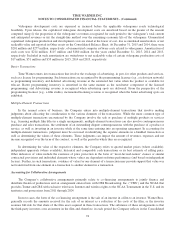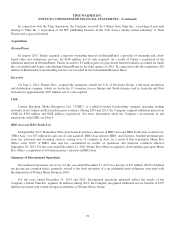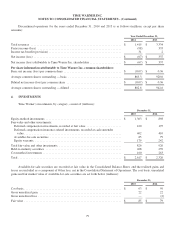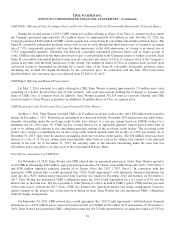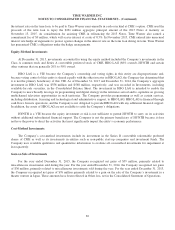Time Magazine 2015 Annual Report Download - page 87
Download and view the complete annual report
Please find page 87 of the 2015 Time Magazine annual report below. You can navigate through the pages in the report by either clicking on the pages listed below, or by using the keyword search tool below to find specific information within the annual report.TIME WARNER INC.
NOTES TO CONSOLIDATED FINANCIAL STATEMENTS - (Continued)
Licensed Programming Inventory Cost Recognition and Impairment
In the normal course of business, the Company’s Turner and Home Box Office segments enter into agreements to
license programming exhibition rights from licensors. A programming inventory asset related to these rights and a
corresponding liability to the licensor are recorded (on a discounted basis if the license agreements are long-term) when
(i) the cost of the programming is reasonably determined, (ii) the programming material has been accepted in accordance
with the terms of the agreement, (iii) the programming is available for its first showing or telecast, and (iv) the license period
has commenced. There are variations in the amortization methods of these rights, depending on whether the network is
advertising-supported (e.g., TNT and TBS) or not advertising-supported (e.g., HBO and Turner Classic Movies).
For the Company’s advertising-supported networks, the Company’s general policy is to amortize each program’s costs
on a straight-line basis (or per-play basis, if greater) over its license period. However, for certain types of programming, the
initial airing has more value than subsequent airings. In these circumstances, the Company uses an accelerated method of
amortization. For example, if the Company is licensing the right to air a movie multiple times over a certain period, the
movie is being shown for the first time on a Company network (a “Network Movie Premiere”) and the Network Movie
Premiere advertising is sold at a premium rate, a larger portion of the movie’s programming inventory cost is amortized upon
the initial airing of the movie, with the remaining cost amortized on a straight-line basis (or per-play basis, if greater) over
the remaining license period. The accelerated amortization upon the first airing versus subsequent airings is determined
based on a study of historical and estimated future advertising sales for similar programming. For rights fees paid for sports
programming arrangements (e.g., National Basketball Association, The National Collegiate Athletic Association (“NCAA”)
Men’s Division I Basketball championship events (the “NCAA Tournament”) and Major League Baseball), such rights fees
are amortized using a revenue-forecast model, in which the rights fees are amortized using the ratio of current period
advertising revenue to total estimated remaining advertising revenue over the term of the arrangement.
For premium pay television and streaming services that are not advertising-supported, each licensed program’s costs
are amortized on a straight-line basis over its license period or estimated period of use, beginning with the month of initial
exhibition. When the Company has the right to exhibit feature theatrical programming in multiple windows over a number of
years, the Company uses historical audience viewership as its basis for determining the amount of programming amortization
attributable to each window.
The Company carries its licensed programming inventory at the lower of unamortized cost or estimated net realizable
value. For networks that generate both Advertising and Subscription revenues (e.g., TBS and TNT), the Company generally
evaluates the net realizable value of unamortized programming costs based on the network’s programming taken as a whole.
In assessing whether the programming inventory for a particular advertising-supported network is impaired, the Company
determines the net realizable value for all of the network’s programming inventory based on a projection of the network’s
profitability. Similarly, for premium pay television and streaming services that are not advertising-supported, the Company
performs its evaluation of the net realizable value of unamortized programming costs based on the premium pay television
and streaming services’ licensed programming taken as a whole. Specifically, the Company determines the net realizable
value for all of its premium pay television and streaming service licensed programming based on projections of estimated
Subscription revenues less certain costs of delivering and distributing the licensed programming. However, changes in
management’s intended usage of a specific program, such as a decision to no longer exhibit that program and forego the use
of the rights associated with the program license, would result in a reassessment of that program’s net realizable value, which
could result in an impairment.
Other Inventory
Inventories other than film and television production costs and licensed programming inventory consist primarily of
DVDs, Blu-ray Discs and videogame development costs and are stated at the lower of cost or net realizable value. Cost is
determined using the average cost method. Returned goods included in Inventory are valued at estimated realizable value, but
not in excess of cost. For more information, see Note 6.
73



